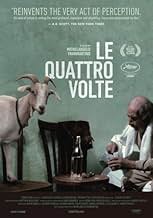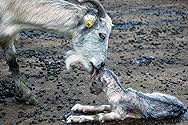Agrega una trama en tu idiomaAn old shepherd lives his last days in a quiet medieval village perched high on the hills of Calabria, at the southernmost tip of Italy. He herds goats under skies that most villagers have d... Leer todoAn old shepherd lives his last days in a quiet medieval village perched high on the hills of Calabria, at the southernmost tip of Italy. He herds goats under skies that most villagers have deserted long ago. He is sick, and believes to find his medicine in the dust he collects on... Leer todoAn old shepherd lives his last days in a quiet medieval village perched high on the hills of Calabria, at the southernmost tip of Italy. He herds goats under skies that most villagers have deserted long ago. He is sick, and believes to find his medicine in the dust he collects on the church floor, which he drinks in his water every day.
- Dirección
- Guionista
- Elenco
- Premios
- 14 premios ganados y 14 nominaciones en total
- Dirección
- Guionista
- Todo el elenco y el equipo
- Producción, taquilla y más en IMDbPro
Opiniones destacadas
My score is more accurately a 7.8/10
As with "The Great Silence," one of the most striking features of "Le Quattro Volte" (The Four Times) is its lack of dialogue. However, whereas for some individuals the 169 minutes of near silence in "The Great Silence" was overly taxing, in this shorter, more widely focused film - quietly reflecting aspects of life in an isolated village in Calabria – the Milanese director Michelangelo Frammartino has given us a predominantly visual poem of place, of space, of people and of the passing of time.
Although not overly religious, it is a spiritually orientated film in which we are asked to consider Pythagoras' contention that we must each know ourselves four times due to the fact that we "have four lives within us - the mineral, the vegetable, the animal and the human".
Therefore within its 88 minute run the small number of central human characters that are featured within it are soon relegated to positions of equality, or of equal vulnerability, before nature. Thus, for example, the goat-herder's animals soon come to the forefront of the film, as do other elements of the animal, vegetable and mineral kingdoms, in order to declare – seemingly – that these other realms also warrant serious and respectful consideration.
An extremely enjoyable and far-from-always-serious film, I found this a beautifully filmed, calming and thought-provoking movie.
I was with two friends of mine: another Calabrian and a Sicilian. I invited them telling the movie was shot in Calabria, but I was worried the plot wouldn't interest them.
I was wrong, this movie astonished the three of us completely: I was not only fascinated by the beautiful views of the Calabrian countryside, but the idea of mixing philosophic concepts with very basic, rural and remote communities still sticks in my mind.
"Le quattro volte" means "the four times" and the movie gives an interpretation of Pythagoras (who taught and settled in Calabria in the 6th century BC) concept of four successive lives that each of us holds: mineral, vegetable, animal and human.
In the movie there are all the elements of this concept shown in a very poetic and amusing way: we have an old goatherd as human, a kidskin as animal, a tree as vegetable and coal (carbon) as mineral. All connected in a cycle of life and death to symbolise the re-incarnation.
The sound of nature and rural human activities is the soundtrack of the movie, it makes us understand we, as human beings, are not at the centre of the universe, we should be aware of the elements we are part of and live in harmony with them.
All this makes Le Quattro volte an absolute masterpiece: 10/10
The doctrine that all things are part of the divine whether a tree, a lump of charcoal, an animal, or a human being is also dramatized in Le Quattro Volte, written and directed by Michelangelo Frammartino. Set in a small village in Calabria in Southern Italy where Pythagoras is said to have lived, Le Quattro Volte is a quietly meditative film that is divided into four sections separated by a blank screen. There is no narration or dialogue other than the dialogue of nature: the bleating of goats, the sheep bells, and the rush of wind blowing through the trees. Frammartino offers no clues or connections to the viewer as to what each segment represents. It is a film, he warns, in which "the viewer must do all the work." As the film opens, an old man (Giuseppe Fuda), emerges out of the smoke rising from a charcoal kiln, tending to his goats in a pastoral setting that may not have changed for hundreds of years. The goat herder has a persistent cough that he tends to by exchanging goat's milk for dust on the floor of the local church and mixing it with a glass of water. When he realizes that his medicine has disappeared, he goes back to the church late at night but it is closed. Without his elixir, he dies the following morning in his bed surrounded by a herd of goats that made their way into his bedroom, one standing on the top of his table.
Taking a page from Sergei Dvortsevoy's Tulpan, the scene shifts suddenly from the darkness of the old man's tomb to the birth of a live goat with its fluid being licked by its mother, a sequence that suggests the continuation of life. We follow the young kid as it grows steadily from taking its first steps to playing with other young goats. His development is interrupted, however, by a ten-minute sequence showing revelers taking part in a passion play celebrating Good Friday. Hilariously the old man's dog, after being chased off by villagers after annoying them with constant barking, retaliates by unblocking the wheels of their truck parked on a hillside causing it to roll down the hill, freeing a herd of goats enclosed in a pen.
As the goats are led through the forest, the baby goat becomes separated from the herd and wanders in the heavy brush until he lies down at the foot of a tall pine tree. With that, the film moves into another stage that shows the process of cutting down and stripping the tall tree. To complete the cycle, the tree is then made into a hut where wood and straw are converted into charcoal to provide heat for the winter, suggesting the oft-repeated phrase from The Book of Common Prayer, "ashes to ashes, dust to dust." Lacking in what is generally considered to be drama or character identification,Le Quattro Volte can be slow going and abstract, a film that rarely engages the emotions, yet it has a serene and contemplative beauty that allows its message of the impermanence of life to become manifest. As Eric Benet put it in his well-known song Dust in the Wind, "Don't hang on. Nothing lasts forever, but the earth and sky, it's there always and all your money won't another minute buy. Dust. . . all we are is dust in the wind. Dust in the wind Time for the healing to begin."
¿Sabías que…?
- TriviaThe film is comprised of long takes. One of them lasts an astounding 8 minutes.
- Créditos curiososThe end credits also include a silver fir, the goats of Caulonia and the coal of Calabria among the cast members.
- ConexionesFeatured in Ebert Presents: At the Movies: Episode #1.15 (2011)
Selecciones populares
- How long is Le Quattro Volte?Con tecnología de Alexa
Detalles
- Fecha de lanzamiento
- Países de origen
- Sitio oficial
- Idioma
- También se conoce como
- Le Quattro Volte
- Locaciones de filmación
- Productoras
- Ver más créditos de la compañía en IMDbPro
Taquilla
- Total en EE. UU. y Canadá
- USD 152,530
- Fin de semana de estreno en EE. UU. y Canadá
- USD 16,192
- 3 abr 2011
- Total a nivel mundial
- USD 717,918
- Tiempo de ejecución1 hora 28 minutos
- Color
- Mezcla de sonido
- Relación de aspecto
- 1.85 : 1
Contribuir a esta página






















